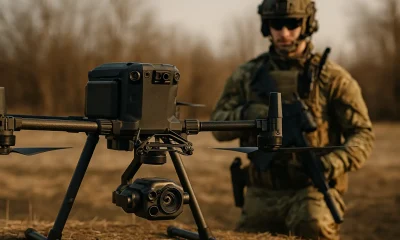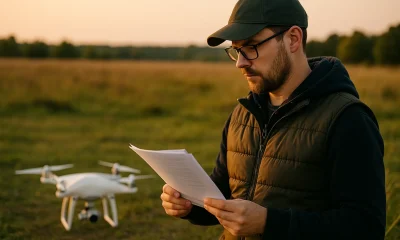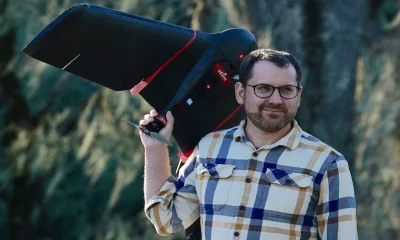- Acronym Guide
- AAM
- ABS
- AC
- ACAS
- ADS-B
- AEHF
- AFAC
- AGL
- AI
- AIM
- ALPA
- ALS
- AM
- AMA
- ANSP
- AOI
- APPI
- AUV
- AUVSI
- ARPAS-UK
- ASTM
- ATC
- ATO
- BLOS
- BVLOS
- CAA
- CAAC
- CAB
- CAP
- CASA
- CATT
- CBO
- CBR
- CBRN
- CDMA
- CDR
- CFI
- CFR
- CIR
- COA
- COMINT
- CORS
- COTP
- COTR
- CPTED
- CV
- C2
- DAA
- DAS
- DEM
- DFI
- DFS
- DGCA
- DHS
- DOD
- DPA
- DPEs
- DRG
- DRO
- DSM
- DSMX
- DSP
- DSSS
- DTM
- EASA
- EFT
- EO
- EOD
- EO/IR
- ELINT
- EMI
- ESC
- EVLOS
- eVTOLs
- FAA
- FCC
- FCS
- FHSS
- FICCI
- FLIR
- FOB
- FOV
- FPS
- FPV
- GBDAA
- GCP
- GCS
- GDPR
- GML
- GNSS
- GPS
- GSD
- GVC
- HDR
- HOGE
- IACRA
- ICAO
- ICS
- IED
- IMU
- INS
- IR
- ISA
- ISR
- ITU
- JARUS
- LAAMS
- LAANC
- LAATM
- LAI
- LAS
- LBA
- LIDAR
- LOS
- LSALT
- MAC
- MAVLink
- MLIT
- MMS
- MSL
- MTOM
- NDAA
- NCSL
- NFZ
- NIST
- NMEA
- NOTAM
- NPA
- NPRM
- NTIA
- OBIA
- OEM
- OFDM
- OGI
- OOP
- OSD
- PAS
- PASM
- PAV
- PCV
- PdM
- PEC
- PIC
- PID
- PIPL
- PLD
- PM
- PN
- PPK
- PPS
- PSM
- PTZ
- PWM
- UAM
- UAOP
- UAS
- UASTM
- UAV
- UCAVs
- UHD
- UHF
- USV
- UTM
- RAIM
- RCC
- RCS
- RED
- ReOC
- RePL
- RFI
- RMS
- ROI
- RPAS
- RPC
- RTH
- RTN
- RTK
- SaR
- SAR
- SARP
- SBAS
- S.Bus
- SBIR
- SEDENA
- SfM
- SFOC
- SIGINT
- SLAM
- SMS
- SOP
- SOPMOD
- SORA
- STANAG
- STTR
- STK
- sUAS
- TCAS
- TCCA
- TFR
- TIN
- TLM
- TOF
- TP
- TPS
- TSA
- VHF
- VLOS
- VTOL
Drone Acronyms
What is ACAS (Airborne Collision Avoidance System)?
Published
2 months agoon
By
Jacob StonerTable Of Contents

Definition
The Airborne Collision Avoidance System (ACAS) is a global aviation safety technology designed to prevent mid-air collisions. It detects nearby aircraft and issues real-time avoidance instructions. These systems use radar, transponders, and onboard sensors to monitor surrounding airspace, assess risks, and guide aircraft to safety when necessary.
Usage
In drone operations, collision avoidance technology enhances situational awareness and ensures safe separation from other air traffic. It plays a vital role in beyond-visual-line-of-sight (BVLOS) flights, high-altitude missions, and within Unmanned Aircraft Systems Traffic Management (UTM) environments. Especially in busy or shared airspace, this technology helps prevent conflicts and supports regulatory compliance.
Relevance to the Industry
As drones are increasingly integrated into airspace with crewed aircraft, onboard avoidance systems are becoming essential for autonomous operations. They are particularly important in commercial applications such as cargo delivery, wide-area mapping, and long-distance BVLOS missions. International bodies like ICAO and EASA support integration of these systems into regulatory frameworks to promote global airspace safety.
How Does ACAS (Airborne Collision Avoidance System) Work?
This safety system detects nearby aircraft and enables drones to take proactive measures to avoid mid-air collisions. Originally developed for manned aviation (as TCAS), modern versions such as ACAS Xa and Xu are designed specifically for UAVs.
Traffic Surveillance and Detection
The drone continuously scans its environment using:
ADS-B (Automatic Dependent Surveillance–Broadcast) signals
Radar transponder responses
Sensors like LiDAR, radar, or high-resolution cameras
These tools identify both transponder-equipped and non-cooperative traffic in real time.
Collision Risk Calculation
Once a nearby aircraft is detected, onboard systems calculate:
Distance and bearing
Vertical and horizontal separation
Relative speed and flight path
The system predicts potential conflicts based on these inputs.
Resolution Advisory and Evasive Action
If a collision risk is detected, an automated advisory recommends a safe maneuver—such as changing altitude, adjusting heading, or reducing speed. In systems designed for drones, this action is typically executed autonomously to ensure immediate response, especially during BVLOS missions.
Return to Original Flight Path
Once clear of the threat, the UAV resumes its planned course. Data from the event is logged for post-flight analysis and, if required, submitted for regulatory review.
This technology provides a vital safety layer for operating UAVs in controlled airspace, enabling reliable deconfliction between aircraft—crewed or otherwise.
Example in Use
“During a BVLOS inspection mission, the drone’s onboard avoidance system detected a low-flying helicopter and automatically adjusted course to prevent a collision.”
Frequently Asked Questions about ACAS (Airborne Collision Avoidance System)
How is this different from standard detect-and-avoid systems?
Typical detect-and-avoid relies on basic sensors and human oversight. This system, however, calculates risks and issues standardized, automated flight maneuvers—functioning similarly to what commercial airliners use.
Is it required on all drones?
No. It is primarily used in advanced or high-risk operations such as BVLOS, flights near airports, or missions involving integration with manned aircraft. Regulations vary by jurisdiction.
Who governs these standards?
Systems like ACAS Xa and Xu are developed by ICAO and backed by regulators like EASA and the FAA. These standards ensure drones operate safely in shared and complex airspace environments.
For examples of these acronyms visit our Industries page.
As the CEO of Flyeye.io, Jacob Stoner spearheads the company's operations with his extensive expertise in the drone industry. He is a licensed commercial drone operator in Canada, where he frequently conducts drone inspections. Jacob is a highly respected figure within his local drone community, where he indulges his passion for videography during his leisure time. Above all, Jacob's keen interest lies in the potential societal impact of drone technology advancements.
Pros
Cons
You may like


Roger Luo, President of DJI – Innovator Series


What is SOPMOD (Special Operations Peculiar Modification)?


What is OSD (Operational Safety Document) & How Does it Work?


Gregory Crutsinger, Founder of Scholar Farms – Innovator Series


What is RED (Rapid Extraction Device) & How Does it Work?


What is IED (Improvised Explosive Device) & How Does it Work?